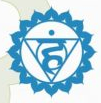What are the 7 Chakras? A Comprehensive Guide to the Energy Centres and Their Effects
- hawkehealthandheal
- Mar 24, 2022
- 5 min read
Updated: Mar 31, 2022
Get to know about the chakras, their attributes, strengths, weaknesses, and relation with yoga. Watch the video at the end and learn how to stimulate and balance these energy centres with their specific mantra (sound) and yantra (sign).

What are Chakras?
The word ‘Chakra’ literally means ‘wheel’. Chakras are the energy centres of the body that spin like a wheel. They are located in the astral body, along the spine, starting at its base and running upwards to the crown of the head. The astral body is the energy body residing inside our physical body. Each physical body part has a corresponding astral body part. The astral body cannot be seen or touched. This is also a reason why we cannot see the chakras.
The chakras radiate a specific color and energy, and each one coincides with a gland in the physical body. Since each chakra relates to specific spiritual, emotional, psychological, and physical aspects of our being, it is believed that their blockage or malfunction can lead to physical, psychological, and emotional disorders. The conscious awareness and balancing of these energy centers, on the other hand, is believed to lead to well-being and good health.
And that is one of the purposes of yoga. Through asana practice, yoga seeks to stimulate and balance these chakras or energy centres in the body.
What is the shape of a chakra?
There are many myths about the shape of the chakras. Some say they are like whirling discs, while others believe they are like flowers hanging from the spine. Some people even think that they resemble an ice-cream cone! All these different ideas exist simply because the chakras cannot be seen by the eyes or by any device. So, we tend to believe whatever becomes commonly circulated.
The ancient scriptures say that a chakra is shaped like a sphere or a ball. And it is even believed that planet earth is a major chakra of the solar system and a minor chakra of our galaxy, the Milky Way. It rotates to distribute some energy, but knowing more about this remains beyond the scope of the human imagination.
Types of Chakras
Mostly, we hear about the primary ‘seven chakras’ but, there are an infinite number of chakras in the human body. But it is easy to start with understanding the primary chakras as these control the main five pranas. A specific vibration, colour, and sound are associated with all 7 chakras. Depending on whether these energy centres are healthy or blocked, you may experience different attributes of your physical, mental, and emotional health.
The primary seven chakras are:

1. Muladhara Chakra – Root Chakra
Colour – Red; Element – Earth
The Muladhara Chakra is located at the base of the spine, between the anus and the genitals. It is characterized by the emotions of survival, stability, ambition, and self-sufficiency. When this chakra is out of balance, a person starts feeling unstable, ungrounded, lack of ambition, lack of purpose, fearful, insecure and frustrated. However, when the root chakra is balanced, these are replaced by more positive emotions, and you feel stable, confident, balanced, energetic, independent, and strong.
The seed mantra (beej mantra) of Muladhara Chakra is ‘Lam’ (pronounced Langm).
Practicing the following postures helps to balance Muladhara Chakra: Tree Pose (Vrkshasana) and Mountain Pose (Tadasana).
To know more, read our article on the Root Chakra.

2. Svadhishthana Chakra – Sacral Chakra
Colour – Orange; Element – Water
The Svadhishthana Chakra is located in the lower abdomen, about four fingers below the navel. Its attributes include the basic need for sexuality, as well as creativity and self-worth. When the sacral chakra is imbalanced, a person may feel emotionally explosive and irritable, sense a lack of energy and creativity, feel manipulative, or be obsessed with sexual thoughts. When balanced, it makes one feel more vibrant, happy, positive, satisfied, compassionate, and intuitive.
The seed mantra (beej mantra) of Svadhishthana Chakra is ‘Vam’ (pronounced Vangm).
You can work on balancing Svadhishthana Chakra by practicing balancing poses like Crow Pose (Kakasana) or standing poses like Triangle Pose (Trikonasana).
To know more, read our article on the Sacral Chakra.

3. Manipura Chakra – Solar Plexus Chakra
Colour – Yellow; Element – Fire
The Manipura Chakra is located at the solar plexus, between the navel and the bottom of the rib cage. This is the most bright chakra amongst all of the seven chakras. Driven by the element fire, it is characterized by anger and aggression. An imbalance of the solar plexus chakra can manifest physically as digestive problems, liver problems, or diabetes. On an emotional level, one might struggle with depression, lack of self-esteem, anger, and perfectionism. By balancing this chakra, we feel more energetic, confident, productive, and focussed.
The seed mantra (beej mantra) of Manipura Chakra (solar plexus chakra) is ‘Ram’ (pronounced Rangm).
Working on Manipura Chakra can be done in poses like Classical Forward Bend (Paschimottanasana), Classical Cobra Pose (Bhujangasana), and Bow Pose (Dhanurasana).
To know more, read our article on the Solar Plexus Chakra.

4. Anahata Chakra – Heart Chakra
Colour – Green; Element – Air
As the name implies, the Anahata Chakra is located in the heart region. Driven by the element air, this chakra is the seat of balance, and it is characterized by emotions of love, attachment, compassion, trust, and passion. When the heart chakra is imbalanced, a person may deal with emotional issues like anger, lack of trust, anxiety, jealousy, fear, and moodiness. By harmonizing this energy center, a person begins to feel more compassionate, caring, optimistic, friendly, and motivated.
The seed mantra (beej mantra) of Anahata Chakra is ‘Yam’ (pronounced Yangm).
Heart Chakra can be balanced by practicing poses like Half Bridge Pose (Ardha Setubandhasana), and Fish Pose (Matsyasana).
Check out our article to know more about the Heart Chakra.

5. Vishuddha Chakra – Throat Chakra
Colour – Blue; Element – Space
The Visuddha Chakra is located at the base of the throat, coinciding with the thyroid gland. It is associated with inspiration, healthy expression, faith, and the ability to communicate well. A blockage in the throat chakra may be experienced as timidity, quietness, a feeling of weakness, or the inability to express our thoughts. When this chakra is balanced, it enables creativity, positive self-expression, constructive communication, and a sense of satisfaction.
The seed mantra (beej mantra) of Vishuddha Chakra is ‘Ham’ (pronounced Hangm).
Throat Chakra is stimulated in poses like Shoulderstand (Sarvangasana) and Plough Pose (Halasana).
Read our article to know more about the Throat Chakra.

6. Ajna Chakra – Third Eye Chakra
Colour – Indigo; Element – None
The Ajna Chakra (pronounced as ‘Agya Chakra’) is located between the eyebrows. Also known as the Third Eye Chakra, it is often used as a focal point during asana practice to develop more concentration and awareness. It is said that meditating upon this chakra destroys the karma of past lives and brings liberation and intuitive knowledge.
Its attributes are intelligence, intuition, insight, and self-knowledge. When imbalanced, it may make you feel non-assertive and afraid of success, or on the contrary, it can make you more egoistical. An imbalance can manifest as physical problems like headaches, blurry vision, and eye strain. When this chakra is active and balanced, a person feels more vibrant and confident, both spiritually and emotionally. In the absence of the fear of death, one becomes his own master and remains free of all attachment to material things.
The seed mantra (beej mantra) of Ajna Chakra is ‘Om’ (pronounced Ongm).
Ajna Chakra is stimulated when practicing Headstand (Shirshasana).
Check our article to know more about the Third-Eye Chakra.

7. Sahastrara Chakra – Crown Chakra
Colour – Violet/White; Element – None
The Sahastrara Chakra is located at the crown of the head. The seventh chakra is the center of spirituality, enlightenment, and dynamic thought and energy. It allows for the inward flow of wisdom and brings the gift of cosmic consciousness. When it gets imbalanced, one might suffer from a constant sense of frustration, melancholy and destructive feelings.
The seed mantra (beej mantra) of Sahastrara Chakra is ‘Aum’ (pronounced Aumn).
Balancing Sahasrara Chakra can be done by practicing Headstand (Shirshasana).
Read our article to know more about the Crown Chakra.








Comments